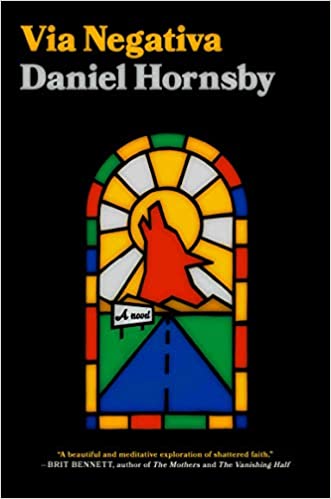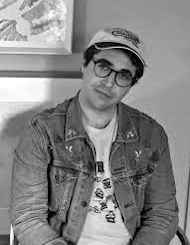“A road is a stripe of death. It requires a streamlined apocalypse to be born: hacking down forests, leveling the ground, blasting through layers of rock. Then, once the road is there, it keeps on killing until it becomes a trail marked by white crosses and piles of deer, stiff raccoons, overturned possum, armadillo bowls, and coyote pelts. Patches of mashed, illegible gore….a black line crossing things out.”
 For a debut novel in which main themes of death and sin underlie much of the action, Daniel Hornsby’s Via Negativa comes as a huge surprise. This story of an unusual person on a most unusual road trip is so engaging that the reader becomes totally caught up in the intrigue of the moment and the character’s sometimes bizarre back-stories as he contemplates his life. Father Dan, an unconventional priest by any standard, is recently “retired” from his life’s calling, “Not simply a priest without a parish, but a priest without a rectory, an address, or a home.” He has been living out of his Toyota Camry for a month, using the showers at truck stops as needed, and carrying a bucket in the car for other purposes, as he lives in his mobile monk’s cell – a “pilgrim, on my way to some holy place.” Though the retired priest raises questions about ancient theology as he drives, this book is not a religious tract or treatise, and Father Dan is not really “priestly” in his behavior. In fact, for this non-Catholic reader, he is more naive and innocent than one would expect a man in his sixties to be, even though his calling must have exposed him to many terrible moral issues and judgments.
For a debut novel in which main themes of death and sin underlie much of the action, Daniel Hornsby’s Via Negativa comes as a huge surprise. This story of an unusual person on a most unusual road trip is so engaging that the reader becomes totally caught up in the intrigue of the moment and the character’s sometimes bizarre back-stories as he contemplates his life. Father Dan, an unconventional priest by any standard, is recently “retired” from his life’s calling, “Not simply a priest without a parish, but a priest without a rectory, an address, or a home.” He has been living out of his Toyota Camry for a month, using the showers at truck stops as needed, and carrying a bucket in the car for other purposes, as he lives in his mobile monk’s cell – a “pilgrim, on my way to some holy place.” Though the retired priest raises questions about ancient theology as he drives, this book is not a religious tract or treatise, and Father Dan is not really “priestly” in his behavior. In fact, for this non-Catholic reader, he is more naive and innocent than one would expect a man in his sixties to be, even though his calling must have exposed him to many terrible moral issues and judgments.
As the novel opens, Father Dan is driving west through Indiana when he sees a coyote bounce off a minivan ahead of him. A kind man, he rescues the coyote, noting that one of its legs appears to be broken, then wraps him in a blanket and braces him in the back seat between the selected writings of Origen and the Venerable Bede’s homilies, anchoring him with a seatbelt. Later, after giving him a tranquilizer, he sets the coyote’s leg, and heads on out in his traveling “monk’s cell,” with the coyote in the back. As he drives, he often listens to his favorite singer, Prince, and “Purple Rain,” his ultimate goal being to reach Seattle to visit some old friends, Brian and Clara, former members of his church in Muncie. He recalls significant events from his work as he drives, including the time he turned over his church to a group of Roma who wanted a place to have a big funeral for a three-day weekend, something which alienated him from his superior and led to a stern warning. At another rectory to which he was assigned, he constructed a geodesic dome as a private retreat space on church grounds, and then a second one as his workshop. People he meets while traveling tell him amazing miracle stories – one about a man who ate glass with no problems, and another in which a man goes out fishing one night and after a terrible battle with a “fish” on his line, reels in Carrie Underwood, his favorite singer.

While at one rectory, Fr. Dan creates a geodesic dome as a private retreat space and another as a workshop.
Occasionally, as he travels, Father Dan is asked to perform services – including one in which he grants forgiveness to a woman who has stolen from both of her parents, and who gives him a gun with a handle made from a human femur, an object which appears and reappears throughout the rest of the novel. Ultimately, he tells of his friend Paul, a priest with whom he attended retreats and with whom he had a long friendship. Paul left the church when he fell in love and became a Unitarian minister, and he was anxious for Dan to perform his wedding – to another man. Dan’s decision is a difficult one for him, especially because of Paul’s sad background with a pedophile priest, which naive Dan never fully understood until it was too late. Additional “adventures” take place when Dan befriends a pyromaniac teen, visits an attraction in a small town – a gigantic paint ball – and picks up a hitchhiker who has love on his mind.
Eventually, some of the philosophies which have interested Father Dan begin to appear here. Of all the theology he has studied, “Via Negativa” is the philosophical idea which he takes most to heart. Found in The Cloud of Unknowing, and written by an anonymous medieval priest, the book “instructs the practice of imageless prayer for young priests and monks, by painting (or unpainting) a mysterious God beyond language,” a program which makes him conclude that “his role is to be on the edge of the outside of things.” This belief fits his personality well and allows him to reject the evil within the institutional church, while also providing him with excuses for avoiding action at critical points, a personal difficulty of Father Dan which the reader notices increasingly as the narrative progresses. Eventually, the reader cannot help feeling that Father Dan has tried to become the equivalent of “Persona Negativa,” if such a thing exists, a person who tries not to recognize the existence and importance of images which flood his mind every time some of his worst memories appear. He also denies himself the ability to atone for the very real “sins” of a past which haunts him. Eventually, he realizes, with a sense of profound guilt, that he is the only person in the world who knows one particularly terrible secret, something upon which he failed to act, and he is devastated.
Readers looking for something thoughtful but not turgid will find much to love here. Though Father Dan seems very naive – and even a little silly, at the beginning – he is a constantly evolving character as he makes his pilgrimage from Indiana to Washington State, with several important stops along the way. Two issues, one involving a friend and one involving an “unfriend,” would create no confusion for most people, but somehow they take him an unusually long time to resolve. Throughout, the reader somehow remains on Fr. Dan’s side, even when s/he wants to throttle him, and when he finally arrives to meet his long-time friends, Brian and Clara in Washington, they provide some new thoughts and insights. Even at this point, however, Father Dan takes no immediate action. In this case however, that is good – at least he does not disappear into a “hole to hell,” like the one he saw in western Kansas. Ultimately, the reader is left with the idea that Father Dan might, at last, make a real decision – all by himself, independent of historical learning, his own past, and his own fears, and just maybe he will find a kind of peace he has never known.
Photos. The coyote photo by Frank Schulenberg appears on https://commons.wikimedia.org
The geodesic dome, which Fr. Dan made on the grounds of the rectory for his use at a private retreat space,. is from https://shelterstructures.en.made-in-china.com
The Cloud of Unknowing, which was the basis of Via Negativa, Fr. Dan’s philosophy, may be found on https://www.thriftbooks.com
The red and blue flowers on Mt. Rainier, which so impressed Fr. Dan, are from https://www.washington.edu
Author photo: By Alice Bolin: https://booksigningevent.com/event/virtual-event-daniel-hornsby/




